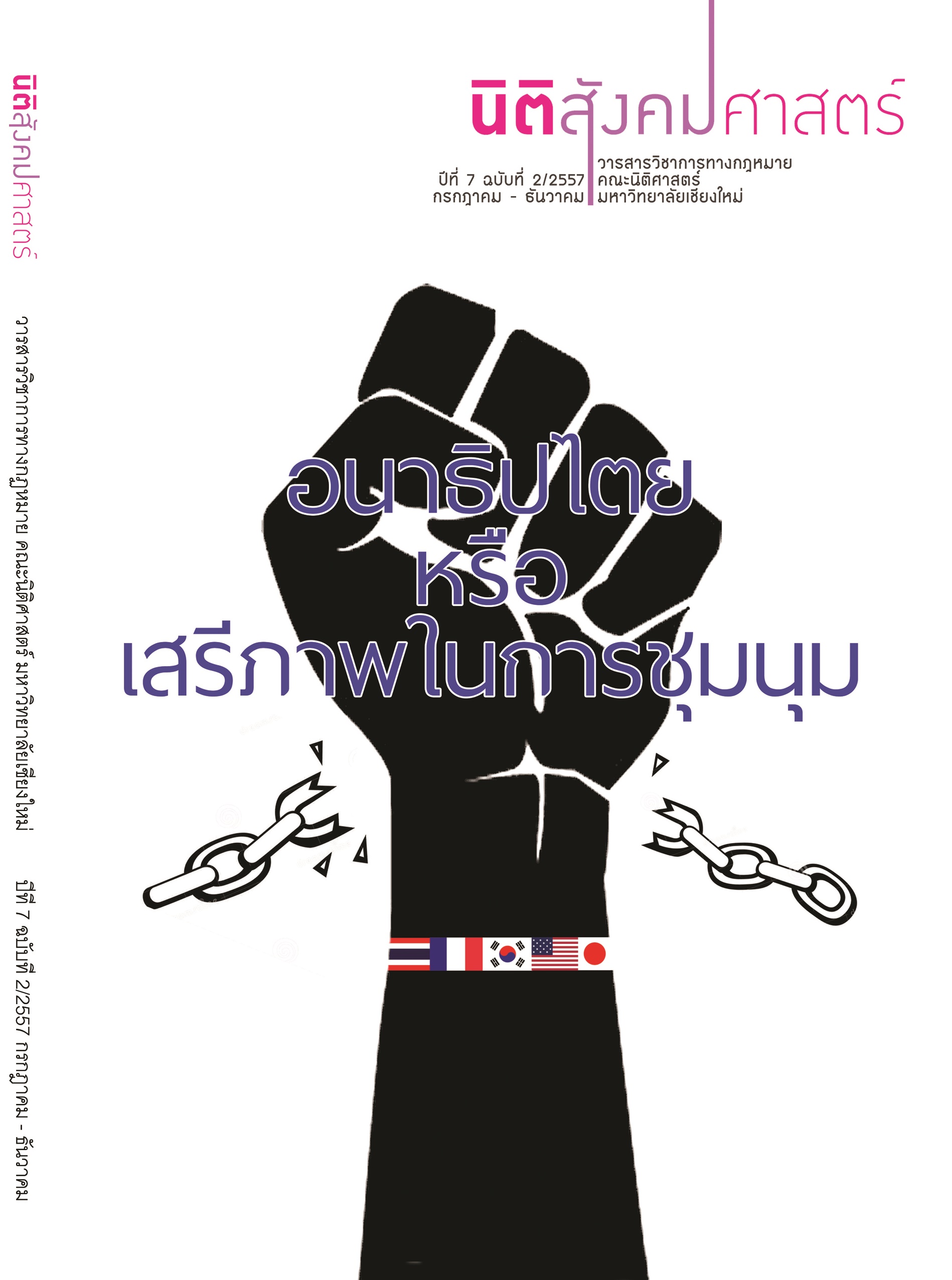กฎหมายการชุมนุมในที่สาธารณะกับสังคมญี่ปุ่น
Main Article Content
บทคัดย่อ
งานศึกษาชิ้นนี้ได้ศึกษากฎหมายเกี่ยวกับเสรีภาพในการชุมนุมของประเทศญี่ปุ่น โดยมีคำถามหลักว่า เสรีภาพในการชุมนุมของประเทศญี่ปุ่นได้รับการรับรองในลักษณะใด ในการศึกษาชิ้นนี้ได้ใช้แนวทางการศึกษาแบบกฎหมายกับสังคม (Law and Society studies) ซึ่งเป็นการศึกษาตัวบทกฎหมายและคำวินิจฉัยของศาลสูงบนโครงสร้างการเมืองและสังคม เพื่อให้เกิดความเข้าใจระบอบของสิทธิที่สมจริงยิ่งขึ้น จากที่วงการศึกษากฎหมายเปรียบเทียบของไทยมักเทียบเคียงตัวบทกฎหมายจากถ้อยอักษรในกฎหมายเป็นหลัก
ผลการศึกษาพบว่า “หัวใจ” ของเสรีภาพในการชุมนุมของญี่ปุ่น คือการประสานงานของศาลสูงกับองค์กรปกครองส่วนท้องถิ่น กล่าวคือองค์กรปกครองส่วนท้องถิ่นทำหน้าที่ออกข้อบัญญัติในการจัดการชุมในแต่ละท้องที่ ตลอดจนการจัดตั้งคณะกรรมการฯ เพื่อพิจารณาอนุญาตให้จัดการชุมนุม จนกล่าวได้ว่าองค์กรปกครองส่วนท้องถิ่นมีส่วนสำคัญอย่างยิ่งในการบริหารจัดการการชุมนุม ในขณะที่บทบาทของศาลสูงคือการรับรองความชอบด้วยกฎหมายต่อปฏิบัติการขององค์กรปกครองส่วนท้องถิ่น โดยการอธิบายเหตุผลทางกฎหมาย เห็นได้ว่าตุลาการญี่ปุ่นไว้วางใจกับองค์กรปกครองส่วนท้องถิ่นมาก ซึ่งเป็นประโยชน์ทั้งต่อสาธารณชนและตุลาการ เพราะผู้มีส่วนได้ส่วนเสียที่สุดในการชุมนุมคือประชาชนที่อยู่ในพื้นที่การชุมนุม การจำกัดเสรีภาพในการชุมนุมจึงพิจารณาจากปัจจัยของประชาชนในพื้นที่เป็นหลัก ในขณะเดียวกันการให้องค์กรปกครองส่วนท้องถิ่นวินิจฉัยเรื่องการชุมนุมย่อมทำให้ศาลสามารถตั้งมั่นอยู่ในความเป็นกลางทางการเมืองได้
อย่างไรก็ตาม ปัจจัยสำคัญ คือโครงสร้างทางสังคมและการเมืองของญี่ปุ่นที่องค์กรปกครองส่วนท้องถิ่นที่เป็นเวทีในการขับเคลื่อนนโยบายสาธารณะของประชาชนได้อย่างมีพลัง ทำให้เกิดผลสองประการ อย่างแรก คือมีการแข่งขันสูงในการเมืองทำให้องค์กรปกครองส่วนท้องถิ่นถูกกำกับจากประชาชนโดยปริยายผ่านการเลือกตั้ง และประชาชนสำนึกว่าการเมืองบนท้องถนนหาใช้วิถีทางเดียวในการขับเคลื่อนประเด็นสาธารณะไม่ บทบาทของการชุมนุมในสังคมญี่ปุ่นจึงเป็นเพียงการแสดงออกเชิงสัญลักษณ์มากกว่าเป็นการชุมนุมเพื่อกดดันรัฐหรือเอกชนโดยตรง การควบคุมการชุมนุมอย่างเข้มงวดในประเทศญี่ปุ่นจึงไม่เป็นการปิดกั้นช่องทางในการมีส่วนร่วมของประชาชนอย่างสำคัญ
This papers is a study of freedom of assembly in Japan by using the methodology of law and society studies. Aim of this study is to find out how the freedom of assembly is treated by the laws and the Supreme Court in political and social contexts. To truly understand the real implementation of the law in society, this study is intent to avoid the method in which only compares the contents of the law,
According to the study, the most important factor in enforcing freedom of assembly in Japan is the cooperation between the Supreme Court and local administrative organization. The local administration play roles in creating the regulations of assembly in its jurisdiction. In addition, the local administration organization law established the Public Safety Commission who has authority to give permission and to manage any public assembly. Hence, the local administrative organization is the key entity in managing the public assembly, while the role of the Supreme Court is to legitimize actions of the local administrator by providing legal reasoning for the decisions of local administrator. This practice can be seen as legal support from the Court for the actions of Public Safety Commission and local administrator. This practice is not only benefit to the public, but also to the Court itself. Because, in case of marching or other demonstration, the most affected group is people who live in the area where the public assembly occurs. Therefore, the local administrator as their political representatives should have priority to decide the case which might damage the public interest. For the benefit of the Court, the case on the freedom of assembly often relates to politics, so it would be better for the Court to stay away from the political conflict and to keep itself politically neutral.
Furthermore, the social and political structure of Japanese society where the local administration is crucial factor to mobilize public policies, so that the practice bases on public assembly between the public administrator committee and the Supreme Court is social mechanism. It becomes empowerment for the people and has two results. First, this situation creates high competition on local politics and also people power through the election. Second, this situation makes the people realizes that the politics on the street, as public assembly, is not the only way to achieve their needs. As a result, the public assembly in Japanese society is not the lethal weapon of the people against the government and the business sectors by itself. Instead, the public assembly is mainly used as symbolic expression. Finally, although the regulations and decisions of the Court hardly allow the public assembly; it hardly concludes that the freedom of expression and public participation in Japan is prohibited.
Article Details
O ความคิดเห็นใดๆ ที่ลงตีพิมพ์ใน CMU Journal of Law and Social Sciences เป็นของผู้เขียน (ความคิดเห็นใดๆ ของผู้เขียน กองบรรณาธิการ CMU Journal of Law and Social Sciences ไม่จำเป็นต้องเห็นด้วย)
O กองบรรณาธิการ CMU Journal of Law and Social Sciences ไม่สงวนสิทธิ์ในการคัดลอกแต่ให้อ้างอิงแหล่งที่มาด้วย
เอกสารอ้างอิง
โกสุมภ์ ธรรมนิตย์. การเมืองการปกครองญี่ปุ่น. เชียงใหม่: คณะสังคมศาสตร์ มหาวิทยาลัยเชียงใหม่, 2526.
ฉัตรทิพย์ นาถสุ ภา. ความเป็นสมัยใหม่กับแนวคิดชุมชน. กรุงเทพฯ: สร้างสรรค์, 2553.
ชูศักดิ์ เที่ยงตรง. 2520. การบริหารการปกครองท้องถิ่นเปรียบเทียบ. กรุงเทพฯ: คณะรัฐศาสตร์ มหาวิทยาลัยธรรมศาสตร์.
เบน แอนเดอร์สั น. ชุมชนจินตกรรม. กรุงเทพฯ: โครงการตำราสังคมศาสตร์ และมนุษยศาสตร์.
หยุด แสงอุทัย. ความรู้เบื้องต้นเกี่ยวกับกฎหมาย. กรุงเทพฯ: มหาวิทยาลัยธรรมศาสตร์, 2552.
อรรถจักร์ สัตยานุรักษ์. Japanization. กรุงเทพฯ: openbook, 2553.
“Country Paper: Japan” [Online], United Nations Economic and Social Commission for Asia and the Pacific, available at www. unescap.org/huset/lgstudy/japan/japan/html (6 January 2013).
Jeff Kingston. Contemporary Japan: history, politic and social change since the 1980s. West Sussex: John Wiley & Sons Ltd., 2011.
Koichi Hasegawa. Constructing Civil Society in Japan: Voices of Environmental Movement. Melbourne: Trans Pacific Press, 2004.
Kurt Steiner. Local Government in Japan. California: Stanford Uni¬versity Press, 1965.
Lam Peng-Er. Green Politics in Japan. London and New York: Rout¬ledge, 1999.
Lawrence W. Beer, “Japan, 1969: “My Homeism” and Political Struggle” in Lawrence W. Beer, Human Rights Constitutionalism in Japan and Asia (Kent: Global Oriental LTD, 2009), p.113-124.
Patricia L. Maclachlan, Consumer Politics in Postwar Japan. New York: Columbia University Press, 2002.
Toshihisa Asano, “Citizen’ movement to protect the water environ¬ment” in Andre Sorensen and Carolin Funck (eds.), Living Cites in Japan: Citizens’movement, machizukuri and local environment (London and New York: Routledge, 2007), p. 189-205.
กฎหมายญี่ปุ่น
THE CONSTITUTION OF JAPAN
THE PENAL CODE
THE LOCAL AUTONOMY ACT
THE METROPOLITAN ORDINANCE NUMBER 44 OF 1950, ENTITLED PUBLIC MEETINGS, MASS PARADE AND MASS DEMONSTRA¬TION
THE ORDINANCE ON THE IZUMISANO CITY COMMUNITY HALL (IZUMISANO CITY ORDINANCE NO.27 OF 1963)
THE HIROSHIMA CITY ORDINANCE ON ELIMINATION OF MOTOR¬CYCLE GANGS (HIROSHIMA PREFECTURE CITY NO.39 OF 2002)
THE ORDINANCE ON ASSEMBLY, MARCHING AND DEMONSTRA¬TION (KYOTO CITY ORDINANCE NO.10 OF 1954)
คำพิพากษาศาลสูงประเทศญี่ปุ่น
(A) No.112
(A) No. 1819
(Bun-Ku) No. 1
(O) No. 762
(A) No. 1187
(A)No.3636
(Ju) No. 808 to 813

